The Amazon River is in the north-central area of South America, and it is the largest river in the world by discharge- but have you met 10 snakes of the Amazon River yet? The tributaries of the Amazon River and this massive river flow through nine countries: Brazil, Peru, Ecuador, Colombia, Venezuela, Guyana, Suriname, French Guiana, and Bolivia.
The Amazon River is the most biodiverse place on Earth. Over 3 million species live in the rainforest. The Amazon River and its tributaries provide critical habitat for countless species of animals, including some of the world’s most fascinating snake species. Come along and meet 10 snakes of the Amazon River.
1. Hydrodynastes Gigas – False Water Cobra
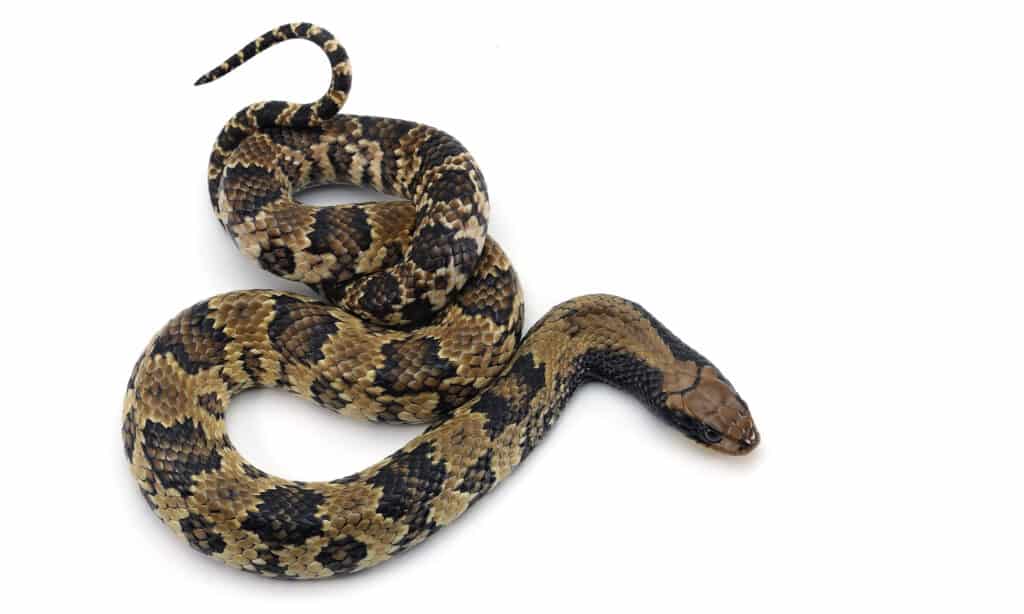
False water cobras look like cobras, can flatten themselves, but are non-venomous.
©PetlinDmitry/Shutterstock.com
The False Water Cobra is a semi-aquatic snake that lives in the Amazon River ecosystem. It prefers humid or wet areas and inhabits parts of eastern Bolivia, Southern Brazil, Paraguay, and northern Argentina. It is a diurnal species that is active throughout the day when they climb, burrow, and swim.
These snakes can flatten their necks to appear cobra-like, larger, and look more dangerous than they really are. However, they cannot prop up themselves vertically, unlike a true cobra. Interestingly, they can also flatten other parts of their bodies.
This nonvenomous species feed primarily on fish, although it will also consume amphibians, reptiles, and small mammals. The False Water Cobra is a constrictor and can reach lengths of up to 8 feet.
2. Oxybelis fulgidus – Green Vine Snake
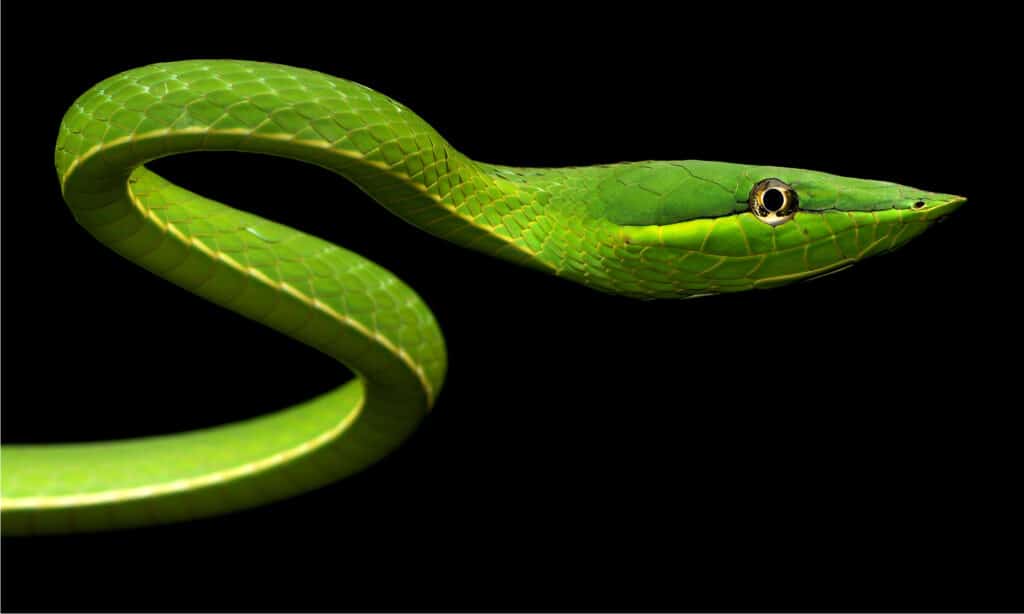
The Green Vine Snake is one of the non-venomous species that live near the Amazon River.
©Ferdy Timmerman/Shutterstock.com
Continuing with our list of 10 snakes of the Amazon River, the Green Vine Snake is a nonvenomous snake found in the Amazon River ecosystem in Central America and northern South America. This slender, brightly colored snake is often mistaken for a venomous coral snake, but it is harmless to humans.
The green vine snake feeds mainly on lizards but will also eat frogs, birds, and bats. It is primarily active in the daytime, climbing trees or moving through shrubs. Green vine snakes are oviparous, meaning they lay eggs.
3. Bothriechis Schlegeli – Eyelash Viper
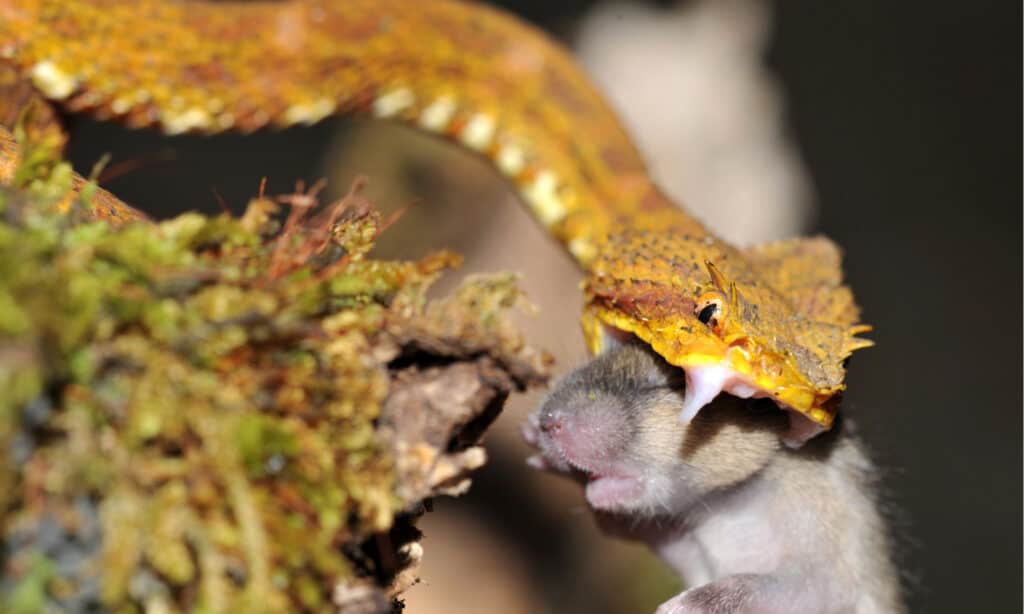
Eyelash Vipers have superciliary scales above the eyes that look like eyelashes.
©worldswildlifewonders/Shutterstock.com
The Bothriechis schlegeli, or Eyelash Viper, is a small and arboreal snake occupying vast stretches of land around the Amazon River throughout Central and South America. This species is notable for its wide array of colors and the superciliary scales above its eyes that look similar to eyelashes. The Eyelash Viper is an integral part of the vibrant Amazon River ecosystem.
The Eye Lash Viper is one of the world’s most venomous snakes. Its venom can cause extensive damage to the tissues and organs; in some cases, it can even be fatal. And even though it is not typically aggressive, it will strike if threatened or provoked.
4. Corallus Caninus – Emerald Tree Boa
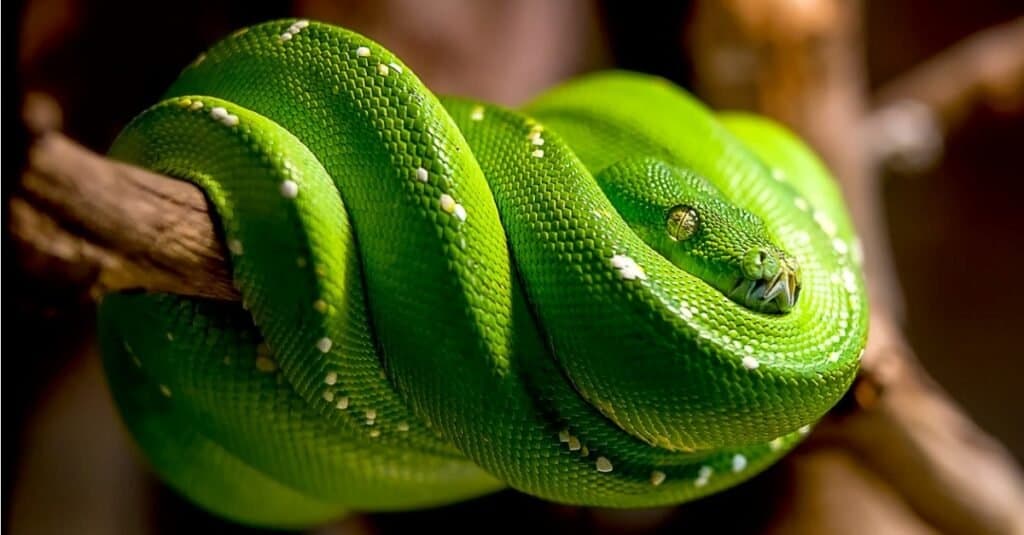
Emerald Tree Boa have prehensile tails that help them grip onto branches.
©iStock.com/timspix58
The Emerald Tree Boa is a permanent resident of the Amazon Rainforest. It is a part of the Boidae family and inhabits many parts of Central and South America. This snake is large, growing up to six feet in length. They have smooth, green scales and a long, thin body. Their head is small, and their eyes are round. Emerald tree boas live in trees and prey on lizards, birds, and small mammals. They have prehensile tails, which allow them to grip onto branches. Emerald tree boas are among the non-venomous snakes found in the Amazon Rainforest and are not dangerous to humans.
5. Micrurus Obscurus – Amazon Coral Snake

Amazon Coral Snake has the strongest and deadliest venom on Earth.
©vampflack/Shutterstock.com
On our list of 10 snakes of the Amazon River, the Amazon Coral Snake is highly venomous. These snakes are indigenous to the western Amazon basin and the nearby foothills of the Andes in Brazil, Bolivia, Colombia, Ecuador, Peru, and Venezuela. Experts state that these snakes have one of the most toxic venoms of any snake on Earth and are responsible for many human fatalities each year.
Regarding their physical appearance, Amazon Coral Snakes are typically reddish-brown or black, with distinctive red, yellow, and black bands running along their bodies. They are slender and small, normally growing between 18 and 20 inches long, but some species can reach three feet in length.
Amazon Coral Snakes are shy and reclusive by nature. They prefer to stay hidden in the dense underbrush of the rainforest. Despite their toxicity, humans do not commonly see Amazon Coral Snakes as they are typically very secretive creatures.
6. Eunectes Notaeus – Yellow Anaconda
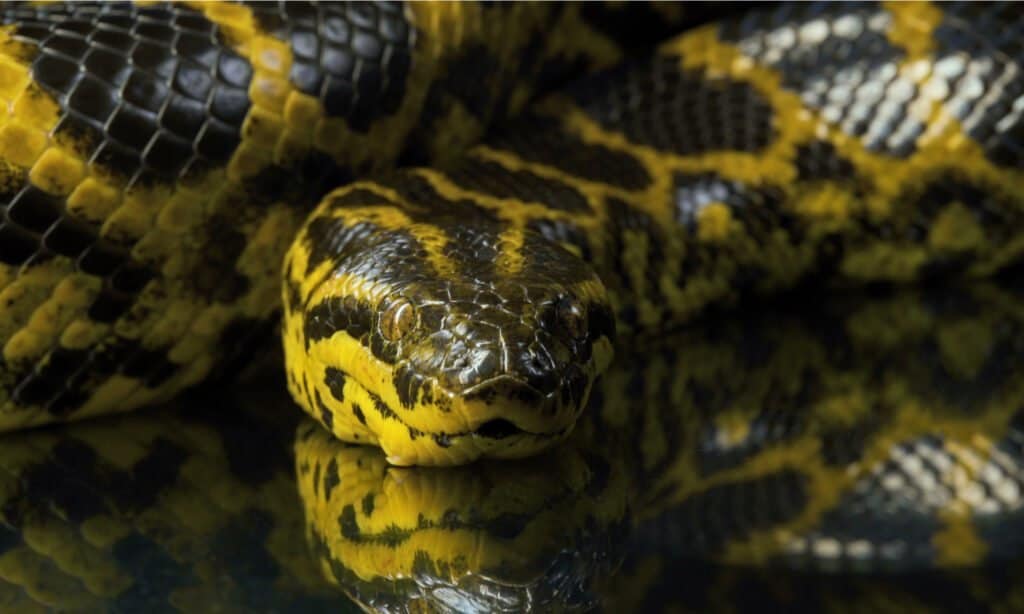
Although experts know little about the natural history of the Yellow Anaconda, they believe it is primarily a nocturnal predator.
©Chris Tefme/Shutterstock.com
The Yellow Anaconda is a boa species endemic to the South American tropical regions. It lives in and around the Amazon River basin. This snake is the largest and heaviest of all the boas, can grow to 30 feet, and weigh up to 550 pounds. The Yellow Anaconda has a distinctive pale yellow or light green coloration, which helps it blend in with its surroundings in the dense rainforest.
Although experts know little about the natural history of the Yellow Anaconda, they believe it is primarily a nocturnal predator. Experts surmise that it feeds on diverse prey, including fish, amphibians, reptiles, and mammals. This species will usually constrict its prey to death before eating it. The Yellow Anaconda is also known to be cannibalistic, so it will consume other snakes, including other boas.
The International Union for Conservation of Nature (IUCN) classifies this snake as a vulnerable species because of restrictions on its habitat range and threats from habitat loss and hunting. However, this snake remains common in much of its range and is not currently facing significant threats to its survival.
7. Bothrops Bilineatus – Forest Pit Viper
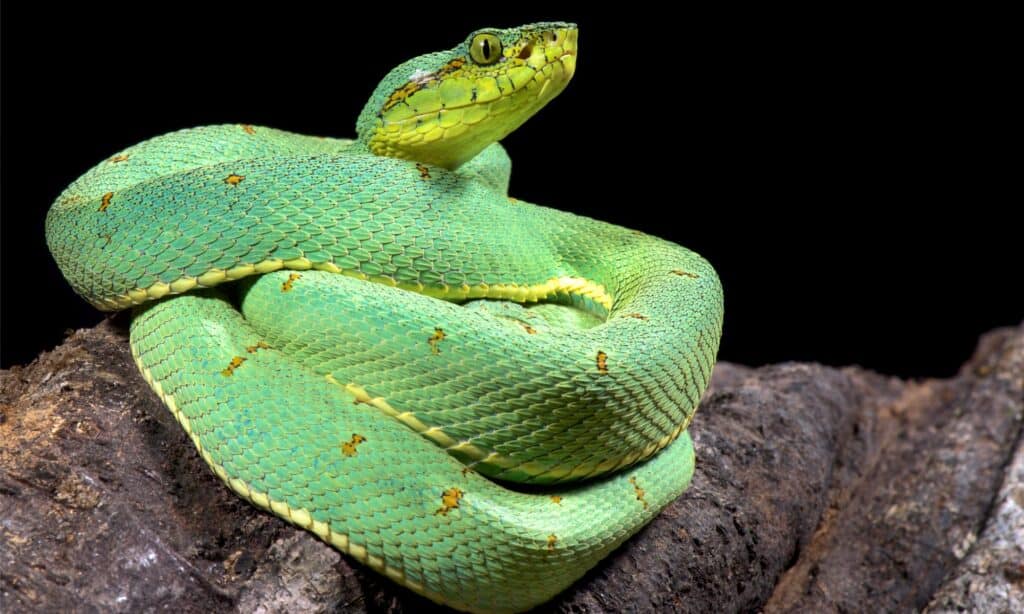
Forest Pit Viper is a species with nocturnal habits, active predominately at night.
©iStock.com/reptiles4all
Forest Pit Vipers are venomous snakes that pervade the Amazon region of South America. This viper is quite terrifying as it is also responsible for many human fatalities yearly, so people should treat it cautiously. Bothrops bilineatus is a species with nocturnal habits, active predominately at night. The Forest Pit Viper can grow to a length of 3 to 4 feet.
This viper feeds on rodents, lizards, and other small prey. It is a timid snake and will usually flee when confronted. However, it will strike if threatened. The venom of the Forest Pit viper is potent and can cause severe tissue damage.
8. Crotalus Durissus – South American Rattlesnake
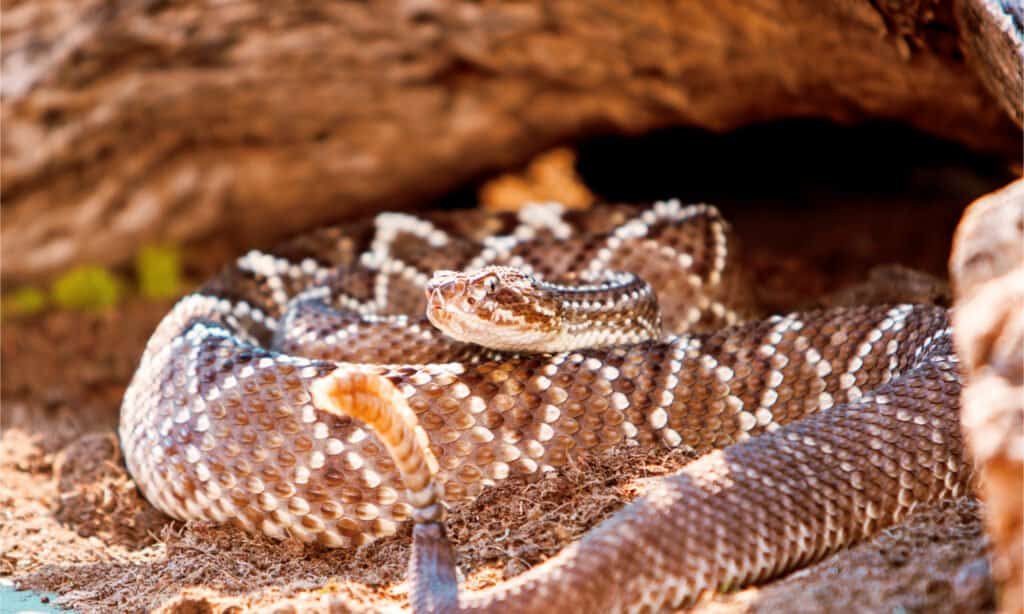
South American Rattlesnakes use their rattling tail to warn off predators and can grow up to 6 feet long.
©GoodFocused/Shutterstock.com
The South American Rattlesnake (Crotalus durissus) is one of the iconic serpents of the Amazon rainforest. This snake is recognizable by its distinctive rattle and fearsome reputation. South American Rattlesnakes are venomous pit vipers found throughout much of South America.
These are medium to large snakes, typically measuring between 2 and 3 feet. They have stout bodies and broad heads with short, rounded snouts. Although their coloring varies, these snakes are generally brown or black with light-colored crossbands. They use the rattles on the ends of their tails to warn predators and prey of their presence.
The venom of the South American Rattlesnake is highly toxic and can cause severe pain, swelling, and tissue damage. However, this snake is not particularly aggressive and will usually only attack if under threat.
The South American Rattlesnake is an important predator in the Amazon rainforest and helps keep the ecosystem balanced. It consumes a diverse diet of small animals, including rodents, lizards, and birds. It is an integral part of the food chain and plays a crucial role in maintaining the health of the rainforest.
9. Bothrops Atrox – Common Lancehead

The Common Lancehead has heat-sensing pits between its eyes and nostrils that help it find prey in the dark.
©iStock.com/reptiles4all
Common Lanceheads are poisonous and have also made their home in the tropical rainforests of South America. This snake is extremely dangerous and should be avoided at all costs. The common lancehead is a pit viper, with heat-sensing pits between its eyes and nostrils that help it find prey in the dark. This snake is typically olive or brown in color, with a distinctive black stripe down its back. It can reach impressive lengths of up to 6.5 feet.
The common lancehead is a predatory snake that feeds on birds, rodents, lizards, and other snakes. It can strike its prey with tremendous speed, delivering a poisonous bite. And because its bite is so toxic, it causes extensive damage to tissues and organs. Victims of a common lancehead snake bite may experience pain, swelling, bleeding, shock, and even death. But, unfortunately, there is no antivenom available for this snake, so if one bites you, it is vital to find medical help quickly.
10. Spilotes Pullatus – Chicken Snake
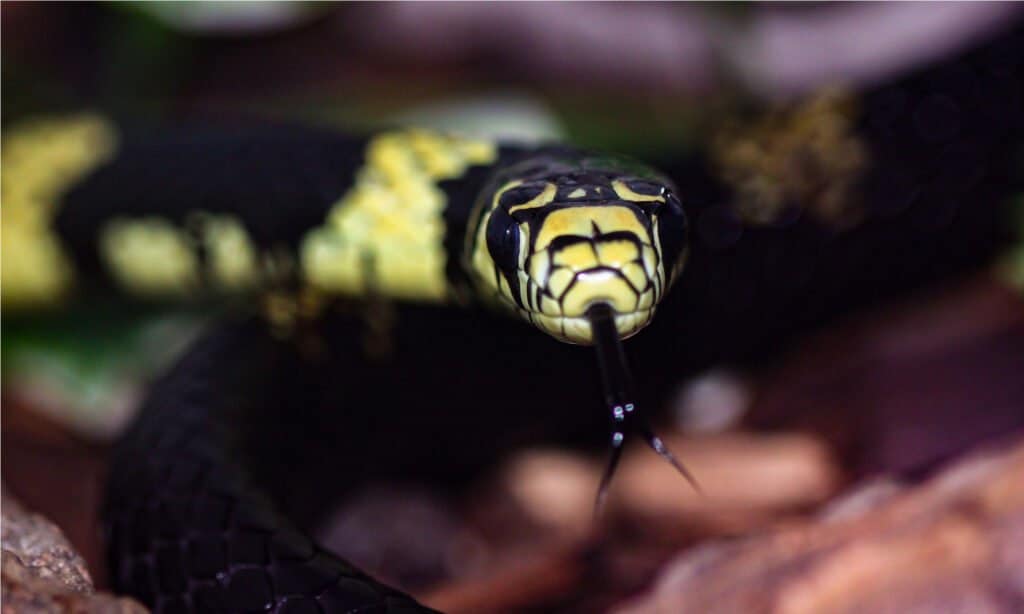
The chicken snake or Spilotes Pullatus belongs to the Colubridae family, grows to 8.2 feet, is non-venomous, digests its food better in warm environments, and lives in Central and South America.
©gabriel_viniciuss/Shutterstock.com
Chicken snakes are non-venomous serpents that are common in the Amazon region. These snakes inhabit areas close to water sources and in wooded areas. Their appearance is typically brown or grey, and they can grow over four feet long.
The Chicken snake digests food better in warm environments, making the Amazon an ideal setting for this species. Because it copes better in a warm environment, this snake thrives on a diet of mainly small rodents, snakes, lizards, and birds that it can easily digest in the warm setting of the Amazon River.
The photo featured at the top of this post is © iStock.com/reptiles4all
Discover the "Monster" Snake 5X Bigger than an Anaconda
Every day A-Z Animals sends out some of the most incredible facts in the world from our free newsletter. Want to discover the 10 most beautiful snakes in the world, a "snake island" where you're never more than 3 feet from danger, or a "monster" snake 5X larger than an anaconda? Then sign up right now and you'll start receiving our daily newsletter absolutely free.
Thank you for reading! Have some feedback for us? Contact the AZ Animals editorial team.






